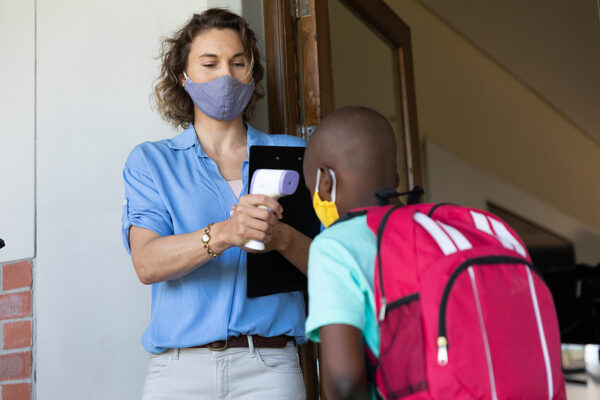This piece was published in The Hill.
Healthy students are better learners. They are more likely to attend school, earn higher grades and graduate from high school. However, too many children, including the 4.4 million who are uninsured, have difficulty accessing comprehensive, quality health care. In turn, these access and quality issues perpetuate chronic, multigenerational health problems.
The pandemic has amplified this stark reality. It has also cast attention on the fact that education and health care are intrinsically connected. To minimize the long-term health and academic impacts of the pandemic on our children and to better prepare for a future public health crisis, President-elect Biden must dramatically improve and expand access to school-based health care.
The fundamental purpose of public education is not to provide health care. However, it has long been recognized that health can be a major impediment to student success. In 1902, America’s first school nurse, Lina Rogers, recognized the connection between health and education. She began promoting good hygiene and educating families about disease to reduce the high rates of absenteeism in New York City due to preventable communicable illness. Her success in furthering a healthy lifestyle among her students sparked a national movement to staff schools with nurses.
Over the next five decades, the role of the school nurse continued to focus on health education but also expanded to include aspects of primary health care delivery, including medication administration, immunizations, health screenings and referrals to critical support specialists when needed. The expansion of the role of the school nurse gave way to school-based health centers by the late 1960s.
School-based health centers create equity by meeting students where they spend a significant amount of their time; in school. Beyond providing critical primary care services, and often mental and behavioral care, centers reduce the practical burdens like scheduling, transportation and costs associated with private health care access that many low-income families struggle with. But only 11 percent of public schools nationwide provide access to centers, and only 40 percent have a full-time school nurse.
We cannot realistically expect these limited in-school services to keep millions of children healthy enough to support the learning that will be required to get them back on grade level academically. That learning will be all the more difficult because of new and exacerbated health challenges.
An overwhelming need for new services to address these issues exists, including catching children up on immunizations, treating the rising tide of anxiety and depression in children ages six to 17 and assessing the impact of increases in opioid and other drug-related overdoses on children.
[Read More: How Education and Health Sectors Can Collaborate]
What better place to concentrate these services than in schools? Schools have demonstrated throughout the pandemic their remarkable will to ensure their students are safe and healthy. Biden must aid them in this effort by providing the resources and support to permanently embed health and wellness into the fabric of public schools across America. Here’s how:
First, the incoming administration should provide states with the resources and technical assistance to launch public-awareness campaigns that focus on childhood health and wellbeing and its importance in enabling students to get back on track academically. These campaigns should help all families identify the qualified service providers in their local area and how to access them.
Second, the administration should close the existing childhood insurance gap. After reaching a record low in 2016, the rate of uninsured children increased a full percentage point to 5.7 in 2019. Closing this gap can be accomplished by creating new incentives to encourage insurance companies to enroll low-income families in Medicaid and removing the administrative barriers that keep families from enrolling their children. Congress can help by extending two provisions put in place early in the pandemic: a higher federal matching rate for Medicaid dollars and a prohibition on dis-enrolling children and families.
[Read More: Public Health and the Safe Reopening of Schools]
To close the child insurance gap, the administration should also provide states with the resources to support the integration of health insurance screenings into existing school-level processes and training school personnel to advise families on how to access public health insurance programs. And it could clear the way for more schools to seek Medicaid reimbursement for the services they deliver. Medicaid currently spends an estimated $4.5 billion annually in reimbursing school-based health care, a figure that could rise as states take advantage of increased flexibility.
Third, it should make school-based health care a critical component of any infrastructure package. This includes, at minimum, doubling the number of school-based health centers and community schools, modernizing facilities and upgrading hardware to support the expansion of telemedicine in schools.
Finally, it must work to make state and local governments more transparent and effective by providing incentives for better integration of child-facing services across the social safety net and eliminating funding inefficiencies across the bureaucracy.
Research demonstrates that healthy children are likely to be more successful adults. At this critical juncture in our children’s lives, it’s time to put this evidence to work by expanding and improving school-based health care.
Mario Ramirez, an emergency medicine physician, served as acting director for pandemic and emerging threats at the U.S. Department of Health and Human Services. He is managing director of Opportunity Labs, a non-profit consultancy and product design firm, and a Senior Fellow at FutureEd, a nonpartisan think tank at Georgetown University. Andrew Buher is the founder of Opportunity Labs, a former chief operating officer of the New York City Department of Education and also a Senior Fellow at FutureEd.


